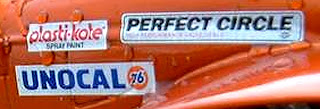Now for another problem to solve. The 1979 edition Tamiya Sand Scorcher used a 2mm green FRP (glass Fibre Reinforced Plastic composite) chassis plate with a 1/16" or so Aluminium lower stiffner plate, now you would think that this combination would be fairly rigid but unfortunately (at least in this particular regard) the chassis is very heavy and flexes alarmingly since there is no second chassis plate on a double deck to tie the front and rear chassis sections together and when you pick the car up you can feel it bow in the middle horridly. The same happens with the new SS2010 edition, as the plate is still only 2mm FRP but now it's a black color. It's not carbon fibre.
So when you do even small jumps with the car using the original very brittle Sand Scorcher 1979 edition PolyStyrene bodyshell the body often quickly gets stress cracks around the body mount hole at the front and around the 2 holes on the rear of the roof section that hold the bodyclip on. The newer Blitzer Beetle shell that I am using is softer and more flexible and thus less prone to cracking but still it's a big problem.
Hence I needed to find a rigid chassis to use. There are several solutions to this problem. One involves using two original FRP chassis plates, but as you might imagine this does not eliminate the issue of chassis flex. There are some 2mm Carbon Fibre chassis plates available from sellers on Ebay but they still suprisingly have NOT got the rigidity that is really needed. I suppose you could use two of these but then the chassis is a black color and I am not much keen on that. Also carbon fibre plates look awful when they have wear on them. Maybe I will try this idea later on though as an experiment.
A TamiyaClub.com (TC) member called Cherrybomb used to make an Aluminium chassis based on the SS1979 (MK1 parts not MK2 so I read) but this is no longer available and in any case I suspect that it would not fit my SS2010 gearbox and other parts etc. TC member TWINSET made an Aluminium chassis way back in 2005 that a lot of TC members bought and it was from HE30 or equivalent grade alloy and was 3mm thick and had side pods for R/C equipment like receiver and Electronic Speed Control (ESC). Unfortunately his drawings for it were in electronic form on the PC in the office at his old job so he no longer has access to them. Also he stropped making them around at least March 2006 so I read.
There is a TC member called Helge which makes a nice chassis in Aluminium but it's 35 Euros which I personally feel is too expensive to justify on this project. Finally there is an Ebay member that sells a 2mm thick chassis with side pods but 2mm Aluminium is too thin, I personally feel.
Hence I have decided to have a go at making my own chassis. I ordered an off cut off Ebay of grade 6082 Aluminium (high strength alloy used for general use in the construction industry) of 540mm x 148mm x 3mm thick from Ebay seller ukroy. Cost was 6 GBP and about the same for postage to NW England where I live. I inspected it when it came and it has some deep gouges for about 2 inches close to the end of the sheet. The original FRP chassis was 235mm long approx., so I was hoping that 540mm would give me 2 chassis' (470mm plus a couple of mm for the blade width when it removes material in the middle) but I wasn't banking on those gouges, but by the looks of it I should still get 2 chassis' out of it. It was quite flat material but not perfectly so, and had the usual guilotene line all the way along one side of the sheet for about 1.5mm or so width, and a bevelled edge there, but that won't be a problem since the chassis pods taper from this max. width inwards towards the front end of the Beetle body anyway.
Here's a pic' of the newly arrived sheet below. Not that exciting to look at yet LOL.
| 3mm chassis raw material just arrived. Shown next to original SS1979 FRP chassis plate for scale. |
| Fortunately I chose to get an offcut rather than a full sheet as it's a lot less expensive on material and postages, and it is already just about the correct width. |
Alistair G.



